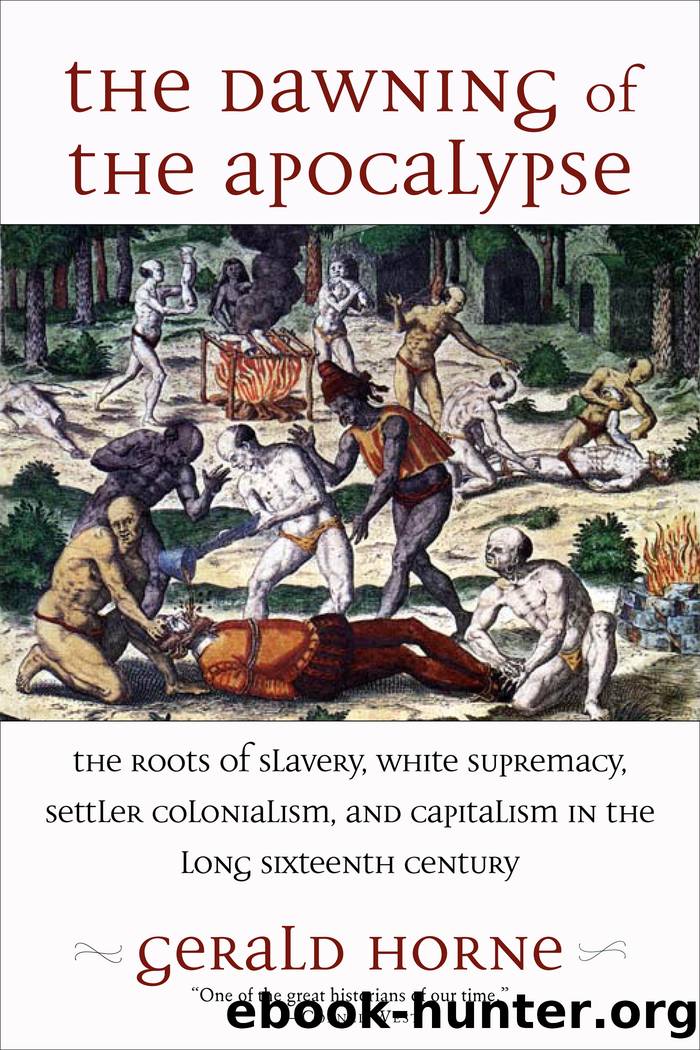The Dawning of the Apocalypse: The Roots of Slavery, White Supremacy, Settler Colonialism, and Capitalism in the Long Sixteenth Century by Gerald Horne

Author:Gerald Horne
Language: eng
Format: epub
Publisher: NYU Press
Published: 2020-07-14T16:00:00+00:00
CHAPTER 7
Origins of the U.S.A.: Indigenous Floridians Liquidated | Ditto for New Mexico
As Spain was stumbling in 1588 in the waters off England, it was encountering similar difficulties in Florida where settlement was affixed more firmly than in territories due north, but things remained rocky nonetheless. By 1580, officials on this North American peninsula were pleased to observe that the soil was fertile but there were not enough settlers to take advantage, an outgrowth of Madrid’s shortsighted religious prerequisites. Officialdom demanded that more of the enslaved be sent from Havana, but this would simultaneously weaken Cuba while placing on Florida’s shores disgruntled workers who had proven themselves quite willing to heed the insistent calls of militant indigenes and French corsairs alike.1
After all, by the 1590s an uptick in importation of enslaved Africans to Cuba meant more marronage (escaping from slavery), in a manner that could portend another Panama where runaway Africans (maroons) had collaborated with Drake, or the disruption provided by Miguel in Venezuela or their peers in Santo Domingo, which had been in a chronic state of conflict with these rebels since the 1520s when they established a foothold in the Baoruco region of the island. It required a major offensive to reduce their strength by the 1590s, which left the colonizer with hardly the stomach or forces to press further regionally. The maroon community of Orizaba in Venezuela was not taken by the settlers until 1609.2 In nearby Brazil, ostensibly Portuguese and inferentially Spanish in light of Madrid’s takeover of the Iberian neighbor, Africans had formed the now fabled Palmares in the late sixteenth century—and maintained it well into the following century—a de facto African state with the potential to destabilize the entire continent.3
In short, the overall strategic situation for Madrid in the Americas, even Florida, was not as strong as it may have appeared at first blush. This was no minor matter since by 1580 news had arrived that corsairs were bonding with indigenes, who were now in the process of organizing rebellion on the peninsula.4 Puerto Rico too was menaced by corsairs, who also were flocking to St. Augustine, which appeared to be a chicken awaiting plucking; due north in Santa Elena indigenes attacked, but like hydraulic engineers, as reinforcements were rushed to bolster the Caribbean, corsairs simply headed north to pressure Florida.5
Settlement leaders were doubtlessly aware of the risks, but they desperately needed someone to build fortifications to blunt the offensive of corsairs and there were not many options. So, Havana was ordered to send thirty enslaved Africans to Florida forthwith,6 with even more pledged.7 St. Augustine was poorly armed, barely fortified, and perpetually in need of more troops, especially after the restive Guale revolted and passed the word that their French allies too were amassing.8 Worryingly for settlers was that the interpreter for the Guale was apparently a French lad.9 A Frenchman was also a primary physician in St. Augustine, while another was the best interpreter of the language used by the Guale,10 yet
Download
This site does not store any files on its server. We only index and link to content provided by other sites. Please contact the content providers to delete copyright contents if any and email us, we'll remove relevant links or contents immediately.
| General | Discrimination & Racism |
Nudge - Improving Decisions about Health, Wealth, and Happiness by Thaler Sunstein(6657)
iGen by Jean M. Twenge(4714)
The Fire Next Time by James Baldwin(4364)
Adulting by Kelly Williams Brown(3700)
The Sports Rules Book by Human Kinetics(3611)
The Hacking of the American Mind by Robert H. Lustig(3597)
The Ethical Slut by Janet W. Hardy(3528)
Captivate by Vanessa Van Edwards(3319)
Mummy Knew by Lisa James(3179)
In a Sunburned Country by Bill Bryson(2962)
The Worm at the Core by Sheldon Solomon(2942)
Ants Among Elephants by Sujatha Gidla(2937)
Suicide: A Study in Sociology by Emile Durkheim(2620)
The Slow Fix: Solve Problems, Work Smarter, and Live Better In a World Addicted to Speed by Carl Honore(2582)
Humans of New York by Brandon Stanton(2387)
Handbook of Forensic Sociology and Psychology by Stephen J. Morewitz & Mark L. Goldstein(2383)
Blackwell Companion to Sociology, The by Judith R. Blau(2324)
The Happy Hooker by Xaviera Hollander(2279)
Outliers by Malcolm Gladwell(2270)
